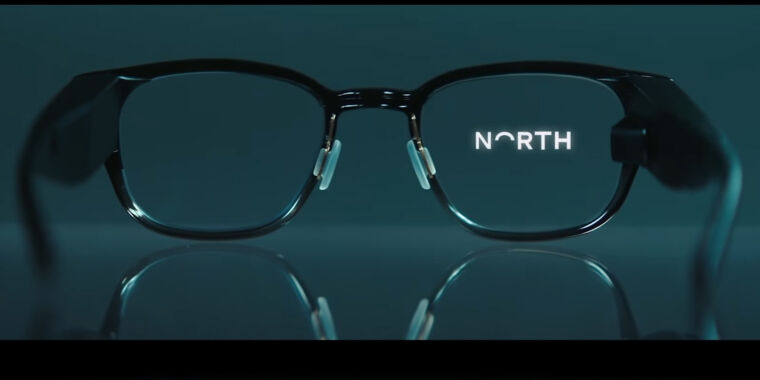-
North’s smart glasses. They look… normal?!
-
The sides are pretty beefy, though.
North -
It’s an easy guess where all the computer components are.
North -
Here’s what the UI looks like. (This image makes the UI apparently much bigger than it really is.)
North -
The thing sticking out on the left side is the laser for the display.
North -
Another view of the laser. The laser bounces off the lens and into your eye.
North -
You control the glasses with this joystick ring! Crazy, right?
North -
The case is also a charging case. Check out how oddly the glasses fold up.
North -
Plugging in the charging case.
North -
Here you can see a power button, speaker, power LED, and pogo pins.
North -
More UI pictures. Here’s a point of interest.
North -
A map icon.
North -
Call an Uber!
North
Google Hardware’s latest acquisition is North, a wearables computing company that most recently was making smart glasses that seemed like a successor to Google Glass. Google Hardware SVP Rick Osterloh announced the purchase on Google’s blog, saying, “North’s technical expertise will help as we continue to invest in our hardware efforts and ambient computing future.”
North developed and released a pair of smart glasses called “Focals,” which came the closest we’ve seen so far to smart glasses that looked like normal glasses. First, the company didn’t neglect the “glasses” part of “smart glasses” and provided the frames in a range of styles, sizes, and colors, with support for prescription lenses. The technology was noticeably less invasive, too. Google Glass’s display surface was a transparent block distractingly placed in front of the users’ face, but Focal’s display surface was the glasses’ lens itself. A laser projector poked out from the thicker-than-normal temple arms and fired into the lens, which has a special coating, allowing the projection to reflect light into the eye.
As you can probably guess from the thicker arms, all the computer components and the battery were smushed into the arms. The device worked a lot like a smartwatch, tethering to your phone for Internet and personal data. It not being a part of the Google or Apple ecosystem duopoly meant a host of app and ecosystem problems, but the glasses supported pop-up notifications, calendar viewing, weather, navigation, Uber, and some kind of messaging support. There was even Amazon Alexa support for voice commands. Like Google Glass, Focals aren’t augmented reality; they’re just a transparent display that shows flat imagery, more like a smartwatch for your face.
The other input mechanism was pretty wild: a joystick ring. You wore the ring around your index finger and could make a fist and control the tiny joystick nub with your thumb, allowing for directional navigation through the UI.
The Focals had some problems, mostly due to the particulars of the laser-beam scanning (LBS) display. The laser stuck out of the temple and reflected off the glasses lens and into the pupil. The angles wouldn’t work as a straight reflection, so a holographic coating was needed on the glasses lens to act as a tiled mirror, directing the laser light into the eye at the right angle. The effective sweet spot was incredibly small, so much so that Focals required every customer to show up to a physical store and have their head 3D scanned to allow a custom pair of glasses to be made for them. Even then, the display was tiny (North’s marketing images, showing a lens-filling image, were not accurate) with only a 300×300 resolution and a 15-degree field of view.
The Focals were anywhere from $600 to $1,000, depending on your color and prescription needs, and launched in 2019. By all accounts, the company was not doing well before Google bought it. After the January 2019 launch, Focals laid off 150 employees in February 2019, a substantial portion of the “over 400 people” it employed. Josh O’Kane, the reporter who broke the acquisition story for the Toronto-based Globe and Mail, said on Twitter, “We’ve learned the company likely sold very, very few Focals and was running out of money.” The company has planned a Focals 2.0 with a better display and lighter body, but with the Google acquisition, those products are canceled.
Google’s smart glasses contribution was, of course, the infamous Google Glass, which launched in 2012 and basically shut down as a consumer product about two years later. (North CEO Stephen Lake actually called Google Glass “a massive failure” in a 2019 tech talk. Awkward!) Most people would think of the product as dead, but Google quietly pivoted Glass to be an enterprise product for assembly-line workers, mechanics, doctors, and other professions that might benefit from hands-free computing. New Glass hardware came out as recently as 2019, with the “Google Glass Enterprise Edition 2,” which featured a modern 10nm Qualcomm SoC. With Apple reportedly building a set of smart glasses, the consumer market will probably heat up again soon.
The acquisition of North is the latest in a burst of purchases from Google’s hardware team. Google bought Fitbit in 2019 for $2.1 billion, its fifth-largest acquisition ever, and the purchase is still waiting for regulatory approval. Also in 2019, Google bought $40 million worth of technology and an R&D team from Fossil Group, a Wear OS smartwatch OEM. In 2018, Google closed a $1.1 billion deal with HTC, bringing the Pixel smartphone design team in-house.
Listing image by North

Lifelong foodaholic. Professional twitter expert. Organizer. Award-winning internet geek. Coffee advocate.

